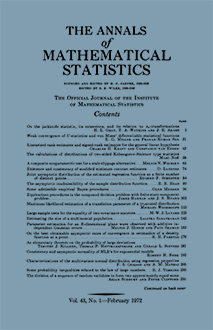Abstract
Several authors have studied the discrete stochastic process $(x_t)$ in which the $x$'s are related by the stochastic difference equation \begin{equation*}\tag{1.1}x_t = \alpha x_{t - 1} + u_t, \quad t = 1,2, \cdots, T,\end{equation*} where the $u$'s are unobservable disturbances, independent and identically distributed with mean zero and variance $\sigma^2$, and $\alpha$ is an unknown parameter. The statistical problem is to find some appropriate function of the $x$'s as an estimator for $\alpha$ and examine its properties. We may rewrite (1.1) as \begin{equation*}\tag{1.2}x_t = u_t + \alpha u_{t - 1} + \cdots + \alpha^{t - 1}u_1 + \alpha^tx_0.\end{equation*} From (1.2) we see that the distribution of the successive $x$'s is not uniquely determined by that of the $u$'s alone. The distribution of $x_0$ must also be specified. Three distributions which have been proposed for $x_0$ are the following: (A) $x_0$ = a constant (with probability one), (B) $x_0$ is normally distributed with mean zero and variance $\sigma^2/(1 - \alpha^2)$, (C) $x_0 = x_T$. Distribution (B) is perhaps the most appealing from a physical point of view, since if $x_0$ has this distribution and if the $u$'s are normally distributed, then the process is stationary (e.g., see Koopmans [4]). However, there are several analytic difficulties which arise in the statistical treatment of this process. Distribution (C), the so-called circular distribution, has been proposed as an approximation to (B) and is much easier to analyze (e.g., see Dixon [2]). Distribution (A) has been studied extensively by Mann and Wald [5]. An interesting feature of distribution (A) is that $\alpha$ may assume any finite value, while for distributions (B) and (C) $\alpha$ must be between $-1$ and 1. From (1.2) we see that a process satisfying (1.1) and (A) has \begin{equation*}\tag{1.3}\operatorname{var}(x_t) = \sigma^2(1 + \alpha^2 + \cdots + \alpha^{2(t - 1)})\end{equation*} If $|\alpha| \geqq 1, \lim_{t = \infty} \operatorname{var}(x_t) = \infty$ and the process is said to be "explosive." Mann and Wald [5] considered only the case $|\alpha| < 1$. They showed that the least squares estimator for $\alpha$ is the serial correlation coefficient \begin{equation*}\tag{1.4}\hat\alpha = \frac{\sum x_t x_{t - 1}}{\sum x^2_{t - 1}}\end{equation*} and that (for $|\alpha| < 1$) this estimator is asymptotically normally distributed with mean $\alpha$ and variance $(1 - \alpha^2)/T$. Rubin [6] showed that the estimator $\hat\alpha$ is consistent (i.e., $\operatorname{plim} \hat\alpha = \alpha$) for all $\alpha$. In this paper the asymptotic distribution of $\hat\alpha$ will be studied under the assumption that the $u$'s are normally distributed. For $|\alpha| > 1$, it is shown that the asymptotic distribution of $\alpha$ is the Cauchy distribution. For $|\alpha| = 1$, a moment generating function is found, the inversion of which will yield the asymptotic distribution.
Citation
John S. White. "The Limiting Distribution of the Serial Correlation Coefficient in the Explosive Case." Ann. Math. Statist. 29 (4) 1188 - 1197, December, 1958. https://doi.org/10.1214/aoms/1177706450
Information





